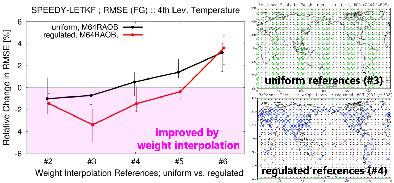当前位置:
X-MOL 学术
›
Q. J. R. Meteorol. Soc.
›
论文详情
Our official English website, www.x-mol.net, welcomes your
feedback! (Note: you will need to create a separate account there.)
Weight structure of the Local Ensemble Transform Kalman Filter: A case with an intermediate atmospheric general circulation model
Quarterly Journal of the Royal Meteorological Society ( IF 3.0 ) Pub Date : 2020-06-16 , DOI: 10.1002/qj.3852 Shunji Kotsuki 1, 2, 3, 4, 5 , Andrew Pensoneault 1, 6 , Atsushi Okazaki 1, 7 , Takemasa Miyoshi 1, 4, 5, 8, 9
Quarterly Journal of the Royal Meteorological Society ( IF 3.0 ) Pub Date : 2020-06-16 , DOI: 10.1002/qj.3852 Shunji Kotsuki 1, 2, 3, 4, 5 , Andrew Pensoneault 1, 6 , Atsushi Okazaki 1, 7 , Takemasa Miyoshi 1, 4, 5, 8, 9
Affiliation

|
The Local Ensemble Transform Kalman Filter (LETKF) computes analysis by using a weighted average of the first‐guess ensemble with surrounding observations within a localization cut‐off radius. Since overlapped observations are assimilated at neighbouring grid points, the LETKF results in spatially smooth weights. This study explores the spatial structure of the weights with the intermediate atmospheric model SPEEDY (Simplified Parameterizations, Primitive Equation Dynamics). Based on the characteristics of the weight structure, we also aim to improve the weight interpolation (WI) method, which we use to compute the weights at coarser reference points and interpolate the weights into higher‐resolution model grid points. The results show that larger localization and sparser observations result in spatially smoother weights. WI is less detrimental when weight patterns are spatially smoother. An advanced WI method with observation‐density‐dependent reference points results in better forecasts than those with uniformly distributed reference points. This improvement may be due to the spatially inhomogeneous localization function realized by the WI method with observation‐density‐dependent reference points. The spatial distribution of the optimal localization scales shows that larger (smaller) localization is beneficial in sparsely (densely) observed regions. The WI method is computationally more efficient with larger ensembles since the additional computational cost for the WI is lower than that for the LETKF.
中文翻译:

局部集成变换卡尔曼滤波器的权重结构:以中等大气总循环模型为例
局部合奏变换卡尔曼滤波器(LETKF)通过使用第一猜测集合的加权平均值与局部化截止半径内的周围观测值来计算分析。由于重叠的观测值在相邻网格点处被同化,因此LETKF导致空间权重平滑。这项研究使用中间大气模型SPEEDY(简化的参数化,原始方程动力学)探索了权重的空间结构。基于权重结构的特征,我们还旨在改进权重插值(WI)方法,该方法用于计算较粗的参考点处的权重并将权重插值到更高分辨率的模型网格点中。结果表明,较大的局部化和稀疏观测会导致权重在空间上更平滑。当权重模式在空间上更平滑时,WI的危害较小。具有与观察密度有关的参考点的先进的WI方法比具有均匀分布的参考点的结果更好的预测。这种改进可能是由于WI方法使用与观测密度相关的参考点实现的空间不均匀定位功能。最佳定位尺度的空间分布表明,在稀疏(密集)观察区域中,较大(较小)的定位是有利的。WI方法在较大的集合中计算效率更高,因为WI的附加计算成本比LETKF的计算成本低。具有与观察密度有关的参考点的先进的WI方法比具有均匀分布的参考点的结果更好的预测。这种改进可能是由于WI方法使用与观测密度相关的参考点实现的空间不均匀定位功能。最佳定位尺度的空间分布表明,在稀疏(密集)观察区域中,较大(较小)的定位是有利的。WI方法在较大的集合中计算效率更高,因为WI的附加计算成本比LETKF的计算成本低。具有与观测密度相关的参考点的高级WI方法比具有均匀分布的参考点的结果更好的预测。这种改进可能是由于WI方法使用与观测密度相关的参考点实现的空间不均匀定位功能。最佳定位尺度的空间分布表明,在稀疏(密集)观察区域中,较大(较小)的定位是有利的。WI方法在较大的集合中计算效率更高,因为WI的附加计算成本比LETKF的计算成本低。最佳定位尺度的空间分布表明,在稀疏(密集)观察区域中,较大(较小)的定位是有利的。WI方法在较大的集合中计算效率更高,因为WI的附加计算成本比LETKF的计算成本低。最佳定位尺度的空间分布表明,在稀疏(密集)观察区域中,较大(较小)的定位是有利的。WI方法在较大的集合中计算效率更高,因为WI的附加计算成本比LETKF的计算成本低。
更新日期:2020-06-16
中文翻译:

局部集成变换卡尔曼滤波器的权重结构:以中等大气总循环模型为例
局部合奏变换卡尔曼滤波器(LETKF)通过使用第一猜测集合的加权平均值与局部化截止半径内的周围观测值来计算分析。由于重叠的观测值在相邻网格点处被同化,因此LETKF导致空间权重平滑。这项研究使用中间大气模型SPEEDY(简化的参数化,原始方程动力学)探索了权重的空间结构。基于权重结构的特征,我们还旨在改进权重插值(WI)方法,该方法用于计算较粗的参考点处的权重并将权重插值到更高分辨率的模型网格点中。结果表明,较大的局部化和稀疏观测会导致权重在空间上更平滑。当权重模式在空间上更平滑时,WI的危害较小。具有与观察密度有关的参考点的先进的WI方法比具有均匀分布的参考点的结果更好的预测。这种改进可能是由于WI方法使用与观测密度相关的参考点实现的空间不均匀定位功能。最佳定位尺度的空间分布表明,在稀疏(密集)观察区域中,较大(较小)的定位是有利的。WI方法在较大的集合中计算效率更高,因为WI的附加计算成本比LETKF的计算成本低。具有与观察密度有关的参考点的先进的WI方法比具有均匀分布的参考点的结果更好的预测。这种改进可能是由于WI方法使用与观测密度相关的参考点实现的空间不均匀定位功能。最佳定位尺度的空间分布表明,在稀疏(密集)观察区域中,较大(较小)的定位是有利的。WI方法在较大的集合中计算效率更高,因为WI的附加计算成本比LETKF的计算成本低。具有与观测密度相关的参考点的高级WI方法比具有均匀分布的参考点的结果更好的预测。这种改进可能是由于WI方法使用与观测密度相关的参考点实现的空间不均匀定位功能。最佳定位尺度的空间分布表明,在稀疏(密集)观察区域中,较大(较小)的定位是有利的。WI方法在较大的集合中计算效率更高,因为WI的附加计算成本比LETKF的计算成本低。最佳定位尺度的空间分布表明,在稀疏(密集)观察区域中,较大(较小)的定位是有利的。WI方法在较大的集合中计算效率更高,因为WI的附加计算成本比LETKF的计算成本低。最佳定位尺度的空间分布表明,在稀疏(密集)观察区域中,较大(较小)的定位是有利的。WI方法在较大的集合中计算效率更高,因为WI的附加计算成本比LETKF的计算成本低。











































 京公网安备 11010802027423号
京公网安备 11010802027423号